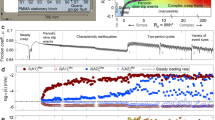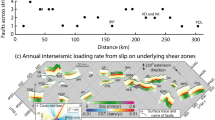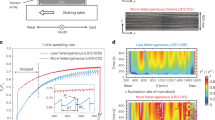Abstract
The problem of how fault rheology and heterogeneity interact to produce the observed scaling of earthquakes (such as the power-law moment–frequency relationship) remains largely unsolved. Rock friction experiments have elucidated the properties of smooth faults1,2,3, but seem insufficient to explain the observed complexity of real fault dynamics4,5. The recognition of a connection between fault-related processes and critical phenomena in other physical systems, together with numerical models of repeated earthquakes, have resulted in significant progress in the theoretical interpretation of earthquake scaling4,5,6,7,8,9,10,11,12,13,14. But fault rheology and heterogeneity have so far been treated separately. Here I attempt to unify the requirements of fault rheology and heterogeneity using numerical calculations of quantized slip in an elastic continuum. I show that cyclical fault strength evolves naturally by means of a statistical selection for high-strength fault patches (asperities), resulting in the accumulation and eventual failure of those asperities. The applicability of these results to real fault systems is supported by a recent analysis of time-dependent earthquake statistics15. These results imply that self-similarity and criticality on a fault emerge during an earthquake cycle, and suggest that the character of local seismicity can be useful in earthquake forecasting by revealing how advanced a fault is within its cycle.
This is a preview of subscription content, access via your institution
Access options
Subscribe to this journal
Receive 51 print issues and online access
$199.00 per year
only $3.90 per issue
Buy this article
- Purchase on Springer Link
- Instant access to full article PDF
Prices may be subject to local taxes which are calculated during checkout




Similar content being viewed by others
References
Dieterich, J. H. Modeling of rock friction 1. Experimental results and constitutive equations. J. Geophys. Res. 84, 2161–2168 (1979).
Ruina, A. Slip instability and state variable friction laws. J. Geophys. Res. 89, 10359–10370 (1983).
Beeler, N. M., Tullis, T. E. & Weeks, J. D. The roles of time and displacement in the evolution effect in rock friction. Geophys. Res. Lett. 21, 1987–1990 (1994).
Rice, J. R. Spatio-temporal complexity of slip on a fault. J. Geophys. Res. 98, 9885–9907 (1993).
Rice, J. R. & Ben-Zion, Y. Slip complexity in earthquake fault models. Proc. Natl Acad. Sci. USA 93, 3811–3818 (1996).
Bak, P. & Tang, C. Earthquakes as a self-organized critical phenomenon. J. Geophys. Res. 94, 15635–15637 (1989).
Sornette, D. in Spontaneous Formation of Space-Time Structures and Criticality(eds Riste, T. & Sherrington, D.) 57–106 (Proc. NATO, ASI, Ser C, 349 Kluwer, Dordrecht, (1991)).
Xu, H. J., Bergersen, B. & Chen, K. Self-organized ruptures in an elastic medium: a possible model for earthquakes. J. Phys. A 25, L1251–L1256 (1992).
Rundle, J. B. & Klein, W. Scaling and critical phenomena in a cellular automaton slider-block for earthquakes. J. Statist. Phys. 72, 405–413 (1993).
Rundle, J. B., Klein, W. & Gross, S. Dynamics of a traveling density wave model for earthquakes. Phys. Rev. Lett. 76, 4285–4289 (1996).
Main, I. Statistical physics, seismogenesis, and seismic hazard. Rev. Geophys. 34, 433–462 (1996).
Burridge, R. & Knopoff, L. Model and theoretical seismicity. Bull. Seismol. Soc. Am. 57, 341–371 (1967).
Rydelek, P. A. & Sacks, S. Earthquake slip rise time and rupture propagation: Numerical results of the quantum earthquake model. Bull. Seismol. Soc. Am. 86, 567–574 (1996).
Ben-Zion, Y. Stress, slip, and earthquakes in models of complex single-fault systems incorporating brittle and creep deformations. J. Geophys. Res. 101, 5677–5706 (1996).
Nadeau, R. M. Characterization and application of microearthquake clusters to problems of scaling, fault zone dynamics, and seismic monitoring at Parkfield, California. Thesis, Univ. California, Berkeley, (1995).
Scholz, C. H. The critical slip distance for seismic faulting. Nature 36, 761–763 (1988).
Scholz, C. H. The Mechanics of Earthquakes and Faulting(Cambridge Univ. Press, New York, (1990)).
Power, W. L., Tullis, T. E. & Weeks, J. D. Roughness and wear during brittle faulting. J. Geophys. Res. 93, 15268–15287 (1988).
Power, W. L. & Tullis, T. E. Euclidean and fractal models for the description of rock surface roughness. J. Geophys. Res. 96, 415–424 (1991).
Schmittbuhl, J., Gentier, S. & Roux, S. Field measurements of the roughness of fault surfaces. Geophys. Res. Lett. 20, 639–641 (1993).
Brown, S. R. & Scholz, C. H. Closure of rock joints. J. Geophys. Res. 91, 4939–4948 (1985).
Marone, C. & Kilgore, B. Scaling of the critical slip distance for seismic faulting with shear strain in fault zones. Nature 362, 618–621 (1993).
Heimpel, M. Earthquake size-frequency relations from an analytical stochastic rupture model. J. Geophys. Res. 101, 22435–22448 (1996).
Andrews, D. J. Astochastic fault model 1. Static case. J. Geophys. Res. 85, 3876–3877 (1980).
Rundle, J. Derivation of the complete Gutenberg-Richter magnitude-frequency relation using the principle of scale invariance. J. Geophys. Res. 94, 12337–12342 (1989).
Acknowledgements
I thank M. M. Wheelock for discussions. This work was supported in part by the Deutsche Forschungsgemeinschaft. Additional research was carried out during a visit to Johns Hopkins University, supported by the National Science Foundation.
Author information
Authors and Affiliations
Corresponding author
Rights and permissions
About this article
Cite this article
Heimpel, M. Critical behaviour and the evolution of fault strength during earthquake cycles. Nature 388, 865–868 (1997). https://doi.org/10.1038/42232
Received:
Accepted:
Issue Date:
DOI: https://doi.org/10.1038/42232
This article is cited by
-
Quantitative Analysis of Seismicity in Iran
Pure and Applied Geophysics (2017)
-
Cohesive strength and seismogenic stress pattern along the active basement faults of the Precordillera-Sierras Pampeanas ranges, western Argentina: An experimental analysis by means of numerical model
Journal of Mountain Science (2009)
-
On stress-forecasting strategy of earthquakes from stress buildup, stress shadow and stress transfer (SSS) based on numerical approach
Earthquake Science (2009)
-
Distinguished seismological and electromagnetic features of the impending global failure: Did the 7/9/1999 M5.9 Athens earthquake come with a warning?
Earth, Planets and Space (2005)
-
The effect of loading rate on static friction and the rate of fault healing during the earthquake cycle
Nature (1998)
Comments
By submitting a comment you agree to abide by our Terms and Community Guidelines. If you find something abusive or that does not comply with our terms or guidelines please flag it as inappropriate.



